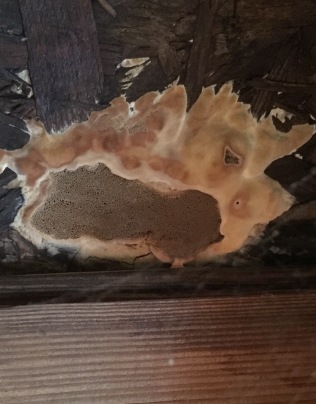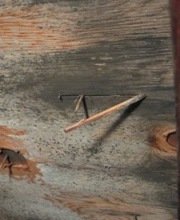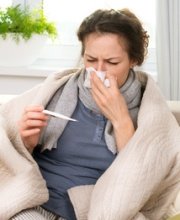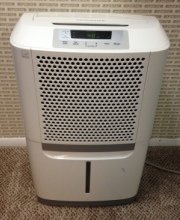Find a Mold Specialist Now
Click or Call, Toll-Free 24/7
Pithomyces in the Home
Pithomyces is a very common mold in the outdoors. Thriving in dark, damp environments, it primarily grows in soil and in piles of dead leaves. If this mold comes indoors, it can grow on damp paper and has been found in ceiling tiles, carpeting and mattress dust. Spores can become airborne, and it is a suspected allergen.
Pithomyces typically grows slowly, and a colony has a cottony texture while the surface color is pale to dark brown. It has a higher rate of growth during the warm, damp months of August, September and October. In the United States, Indiana and nearby states have a high incidence of this mold growth.
Health Issues From Exposure to Pithomyces

Pithomyces is not a significant health threat to humans. It can create sporidesmin, a toxin that causes serious illness in farm animals, but toxic strains of the mold typically only occur in New Zealand and Australia. In North and South America, it is considered a non-toxigenic mold.
That said, even non-toxic mold can be an allergen or irritant. According to the US Environmental Protection Agency (EPA), physical reactions to indoor mold can include sneezing, runny nose, red eyes or skin rash. Asthma symptoms such as coughing and wheezing can also be associated with mold allergies. Because mold sensitivity can mimic hay fever and similar allergies, you may not realize the actual cause of your symptoms. By removing this mold from your home though, you should get significant relief from your suffering.
What To Do If You Have Pithomyces in Your House?
Even without the threat of major health problems, it is never a good idea to allow mold to grow in your house. If paper is involved (such as books getting wet but not dried properly), you could end up with a pithomyces colony on your hands. Be alert to any dark, damp areas of your home – many types of mold can grow in similar conditions, and it’s important to address the problem quickly.
If you have moldy books or other papers that you want to keep, first allow them to dry. You can place paper towels between the pages to help facilitate the drying process. Then place the books on a towel, and lay them out in the sun. The UV rays from the sun will help to kill any remaining mold.
Once the pages are dry, use a HEPA vacuum to remove the surface mold from the paper, and clean the underlying surfaces before returning the items to their bookshelves or tables. For valuable books, you should consult with an expert.
Vacuum other surfaces that may harbor mold dust such as carpet and mattresses regularly with a HEPA vacuum. Ceiling tiles are porous and cannot be cleaned; they have to be replaced if they become moldy.
Here is more on dealing with mold in the home.
How to Prevent Mold
Mold grows in damp conditions, so eliminating excess moisture in the home is key to preventing an outbreak. We, and the EPA, strongly recommend that you always fix plumbing leaks promptly, and keep indoor humidity within the range of 30-50 percent. Vent bathrooms and dryers to the outside, use exhaust fans when cooking and use de-humidifiers and air conditioners during humid summer months.
Poor insulation around windows can cause condensation that contributes to mold growth. Replace or improve the insulation, and consider getting new windows if condensation is an ongoing problem.
Clean up small areas of mold growth quickly before they spread. Clean mold off of non-porous surfaces using detergent and water, and dry thoroughly. Porous items like fabric, insulation and carpet will need to be thrown away and replaced. If you are not sure about an item, it is best to ask a mold remediation professional.
Removing Mold
If you have mold in your home, without testing you will not be able to identify whether it is pithomyces or another more dangerous type of mold. It really doesn’t matter though, all mold needs to be removed. To understand the extent of your mold problem and the proper way to handle it, we recommend that you get a free home assessment from a mold remediation expert in your town. Just follow the link to get a list of experts near you.
If you’ve caught the mold growth early, you may decide that you can remove it yourself. The EPA suggests that an area of 10 square feet or smaller can usually be handled by the homeowner. You’ll need the proper equipment, including gloves, goggles and a mask to protect yourself from inhaling mold spores, a HEPA vacuum and an antimicrobial cleaner. Mold can easily become airborne and spread during the removal process, so the work area should be sealed off with heavy plastic and tape. Here is more on removing mold yourself.
A mold remediation professional will let you know what needs to be done to properly and safely remove the mold, and give you a detailed written estimate for doing so. Choose this option if you are sensitive to mold or have allergies, or the mold growth has spread and is causing structural issues. Remember to address the cause of the mold, too, or else the mold will come back and cause more problems to your home and your health.
The EPA says you should hire a professional to handle your mold issue if it is the result of extensive water damage, or if the mold covers an area of 10 square feet or more. You will also need to consult a specialist if the mold is growing in your air ducts. If you suspect you do have mold there, do not run your heat or air conditioning because it will blow mold spores to other parts of your house. Additionally, if your mold issue was caused by a sewage backup or flooding, you should use a professional.
Return From Pithomyces To Our Main Mold Types Page
Privacy Policy Terms and Conditions Accessibility Do Not Sell My Information Disclaimer Contact Us




